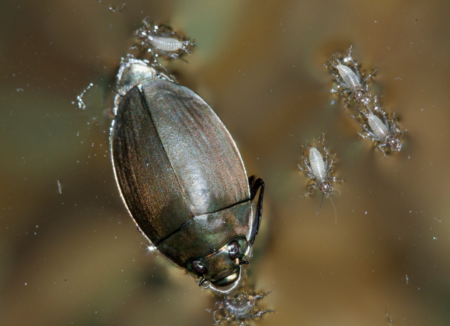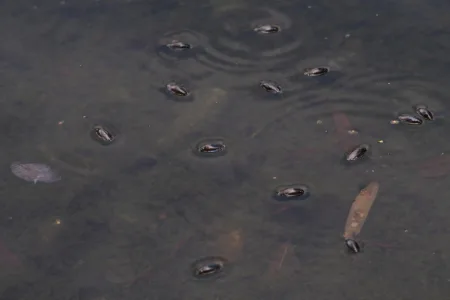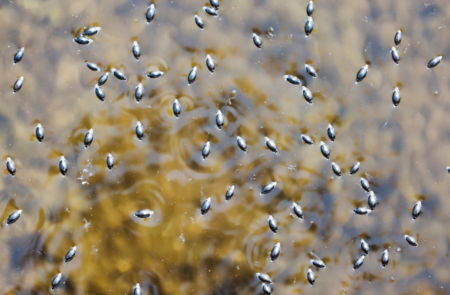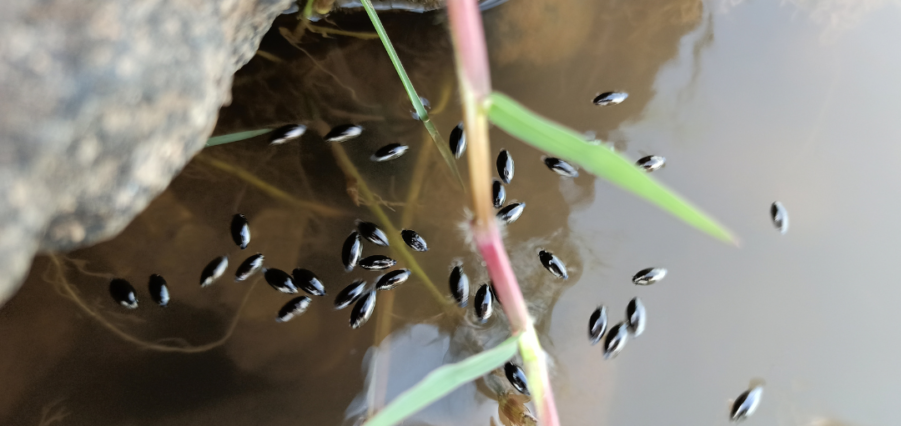Freshwater environments like rivers, streams, lakes, and wetlands are filled with fascinating nature. Teeming with life, they are great natural settings for outdoor activities and among the best for doing sit-spots. If you pause by a body of water in late Summer or Fall, you may be treated to the antics of our latest Wildlife Spotlight: whirligig beetles.
Beetles are the most diverse order of insects on Earth. There are hundreds of thousands of species! So what makes whirligigs so special? Let’s find out. These aquatic speedsters are often called “nature’s bumper cars” for their fast, chaotic movements. Others call them “apple beetles” for a surprisingly strange reason. Curious? Read on!
What are whirligig beetles?

Whirligigs are fully aquatic beetles belonging to the family Gyrinidae. Like all insects, they have six legs, compound eyes, three body segments, and two pairs of wings. Their outer pair of wings is hardened to a pair of elytra, or protective wing cases, which are characteristic of beetles. There are around 900 species of whirligigs, and they are generally all very similar in appearance and behavior.
Whirligigs spend almost all of their time swimming rapidly around on the surface of calm, fresh water. They are especially common in small creeks and along the margins of larger rivers, wetlands, lakes, and ponds. Unlike other aquatic beetles like diving beetles, they almost exclusively spend their time paddling along the water’s surface. Famously, whirligigs are incredibly mobile on the water’s surface, moving around quickly with chaotic changes in directions.
What do they look like?
Whirligigs are typically dark-colored, sleek, and shiny. They remind me of large watermelon seed with a metallic sheen. Their legs and antennae don’t stick out far from their body, which gives them a very smooth and rounded appearance. Some species may be larger than others, or have different colors and degrees of shininess.
What do whirligig beetles eat?
They are carnivorous, and feed on insects that fall into the water and get stuck in its surface tension. For more on predatory aquatic insects, check out my post on water striders! Whirligigs are typically nocturnal, and hunt by feeling the vibrations of prey on the surface. Their front legs are enlarged and adapted to grabbing their prey and bringing it to their mouth. Scientists call these limbs raptorial appendages.
Meanwhile, whirligigs’ four rear legs are short and paddle-like with many tiny hairs that increase their pull on the water. These paddles work constantly to propel the whirligig beetle along in the water. They have amazing acceleration and maneuverability!
Where can you find them?

Whirligig beetles are strictly aquatic; unless you find one attracted to your lights in summer, they will only show up in water. They typically prefer calmer, more tranquil waters with less turbulence and fewer ripples. This helps them more easily find prey, and presumably avoid getting lost or disoriented in the water. Whirligigs also avoid areas with dense vegetation, which is an obstacle to their speeding around!
Since they are excellent swimmers and also capable of flying, whirligigs occur all over the world. In fact, they occur in fresh water bodies virtually all over the world. The major exception seems to be the greater part of Polynesia, where large oceans separate some islands from the nearest freshwater habitat. This includes places like Hawai‘i, which are probably too remote for whirligig beetles to ever reach on their own.
What makes whirligig beetles special? Cool facts about whirligig beetles

Now that we’ve learned the whirligig beetle basics, let’s get to some cool facts. If you’re looking for others animal facts posts, be sure to check out scary animal facts, weird animal facts, and facts about bats!
Whirligigs are some of the most efficient swimmers in the natural world
As I mentioned earlier, all but the whirligigs front legs are perfect for swimming. With all four beating together, they can generate a surprising amount of force. In fact, scientific studies on whirligigs estimate that they have the most efficient swimming in the animal kingdom. In other words, they generate the greatest amount of thrust (push against the surrounding water) per stroke of any animal!
This makes it no surprise that whirligigs are extremely fast for their size. Fascinatingly, their odd, circuitous (wiggly) travel paths are actually more efficient than straight ones given their swimming style.
They are highly social and gather together for safety
Especially during the day, whirligigs will gather in large groups to avoid being singled out by predators. Because we humans are usually most active during daytime, you will almost always find whirligig beetles in these groups, which naturalists call rafts. By staying in a raft, the whirligigs enjoy safety in numbers.
Additionally, one of their best defenses works especially well in groups. When they feel alarmed or threatened,
Whirligig beetles have “four eyes”!
Insects typically have two large, compound eyes composed of many smaller light-sensitive organs. These “facets” form a sort of mosaic image that the insect uses to perceive its environment. Because whirligigs spend their time on the border between water and air, they have specially adapted eyes. Their two compound eyes have each split into an upper (above water) and lower (below water) part. In a sense, this means that their two compound eyes have split into four!
The top two eyes are better able to make out color and form images looking through air. By contrast, the lower eyes are more sensitive to light to see in the gloom of the water. These eyes help whirligigs spot and avoid predators from both above and below. Because of this great adaptation, whirligig beetles can constantly keep an eye on their total environment, in the water and air.
Some whirligig beetles smell like apples when frightened
With all that speed and all those eyes, it can be very hard to catch whirligig beetles. If you do manage to capture one, you may notice an odd scent. Whirligig beetles, like stink bugs, secrete defensive chemicals from their bodies when threatened. Interestingly, for some species the scent can be somewhat fruity! This earned them their rather odd common name “apple beetles”. That, and in my opinion they look like big appleseeds.
They can sense fine vibrations in the water
One odd thing that you may notice about whirligig beetles is a lack of obvious antennae. While these highly diverse organs are usually pretty obvious on most beetles, they are hard to spot with whirligigs. This is because their antennae have become very small to avoid dragging in the water. They don’t project very far from the head. Nonetheless, they serve a very important function for the insect: sensing the behavior of the water around them.
Just like how water striders have a keen sense of the vibration of the water membrane they perch on, whirligigs can sense similar disturbances. This enables them to locate prey much in the way that bats use echolocation. Thanks to their tiny, odd little antennae, can sense ripples in the water coming from struggling insects and pinpoint their location. A special cup-shaped Johnston’s organ helps them do this to a very accurate degree. They can even emit their own ripples and “listen” for the way they bounce back off of potential objects and other whirligigs!
They make their own scuba tanks
When the going gets tough, whirligigs often try to escape predators by diving underwater. However, like other adult insects, they still need to breathe air (they don’t have gills). Whirligigs have a surprising solution to this problem: a natural scuba tank! They carry a bubble of air under their elytra (wing cases) as they swim underwater, and oxygen from the nearby water diffuses into it. Meanwhile, carbon dioxide from their breathing diffuses out.
With this excellent scuba tank, whirligigs can stay underwater for several minutes at a time!
Closely related to some of our best garden friends
One of the first things many nature lovers learn about wildlife gardening is that it can attracted beneficial insects that protect plants. One of the most common and helpful examples are the ground beetles in the family carabidae. These delightful, pretty and active beetles are voracious predators of caterpillars, grubs, and other potentially harmful garden pests. Interestingly, whirligigs are closely related to these predatory beetles, which makes me like them even more!
Want to know more about whirligig beetles? Check out this podcast!
Thanks for reading about whirligig beetles!
Have you encountered these fascinating insects in your own neck of the woods? Share with us in the comments! If you enjoyed this post and would like to support Gulo in Nature, please share it with friends and follow us on Social Media. If you’d like to see other topics featured on the blog, let us known using the Contact Page!

